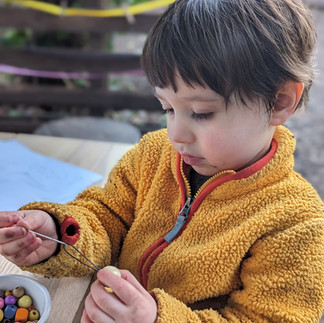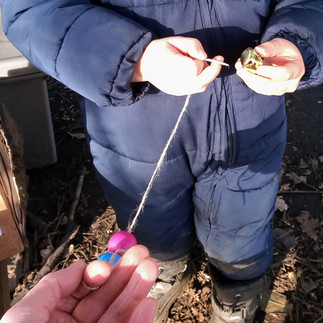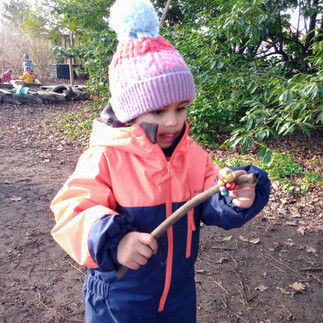
Instead of a book of the week, this week we sang nursery rhymes and encouraged the children to clap and sing along.
Weekly Activities
During morning base camp, a practitioner held a pre-made percussion stick behind their back and started shaking it. She shook it quietly to begin with to see who was listening, then more loudly; the children listened intently and began pointing to where the sound was coming from. We then showed them the percussion stick and explained that this week’s activity was to make an instrument. The children voted on a nursery rhyme to sing [If you're happy and you know it] and the practitioner shook the percussion stick in time to the beat. The children were encouraged to clap and sing along.
N.B.
Beat: the beat never changes, it is like a heartbeat.
Rhythm: it changes and can be a combination of short or long sounds.
To make their own percussion sticks the children had to find a stick (shorter than the length of their arm); some were even able to find ‘y’ shaped sticks. They cut a piece of twine or wool using secateurs or scissors and started threading on some bells and beads. We helped the children to tie the twine onto their stick. We asked the children to count how many bells/beads they had threaded. We then encouraged them to experiment with making different sounds.
At the lunch and home time base camps, we continued to encourage the children to continue experimenting with sounds: could they shake loudly/quietly; could they start and stop at the signal; could they follow and repeat a simple rhythm...
Aims and Objectives
Follow and repeat a simple rhythm
Discriminate and reproduce loud and quiet sounds
Listen and respond to the beat of a nursery rhyme
Experience and develop an awareness of sounds made with the percussion stick
Develop their fine motor skills
Home Activity
Grab a some sticks and tap out a drumbeat! All you need is a sturdy pair of sticks and a tree stump, and you’ve got your woodland drum. Try your drumsticks on different textures is there a difference in the sound? Paint your drumsticks bright colours, or draw a pattern on them.
Make your own woodland-inspired wind chime. Collect a handful of long, straight, dry sticks, paint them and hang them up. Ta-da! Your very own woodland wind chime. Try sticks of different shapes, sizes and wood - do they sound different? Paint your sticks bright colours, or draw a pattern on them. Can you make any other woodland inspired instruments?
Please upload any instruments you make at home onto Tapestry so we can show all the children.






































































コメント